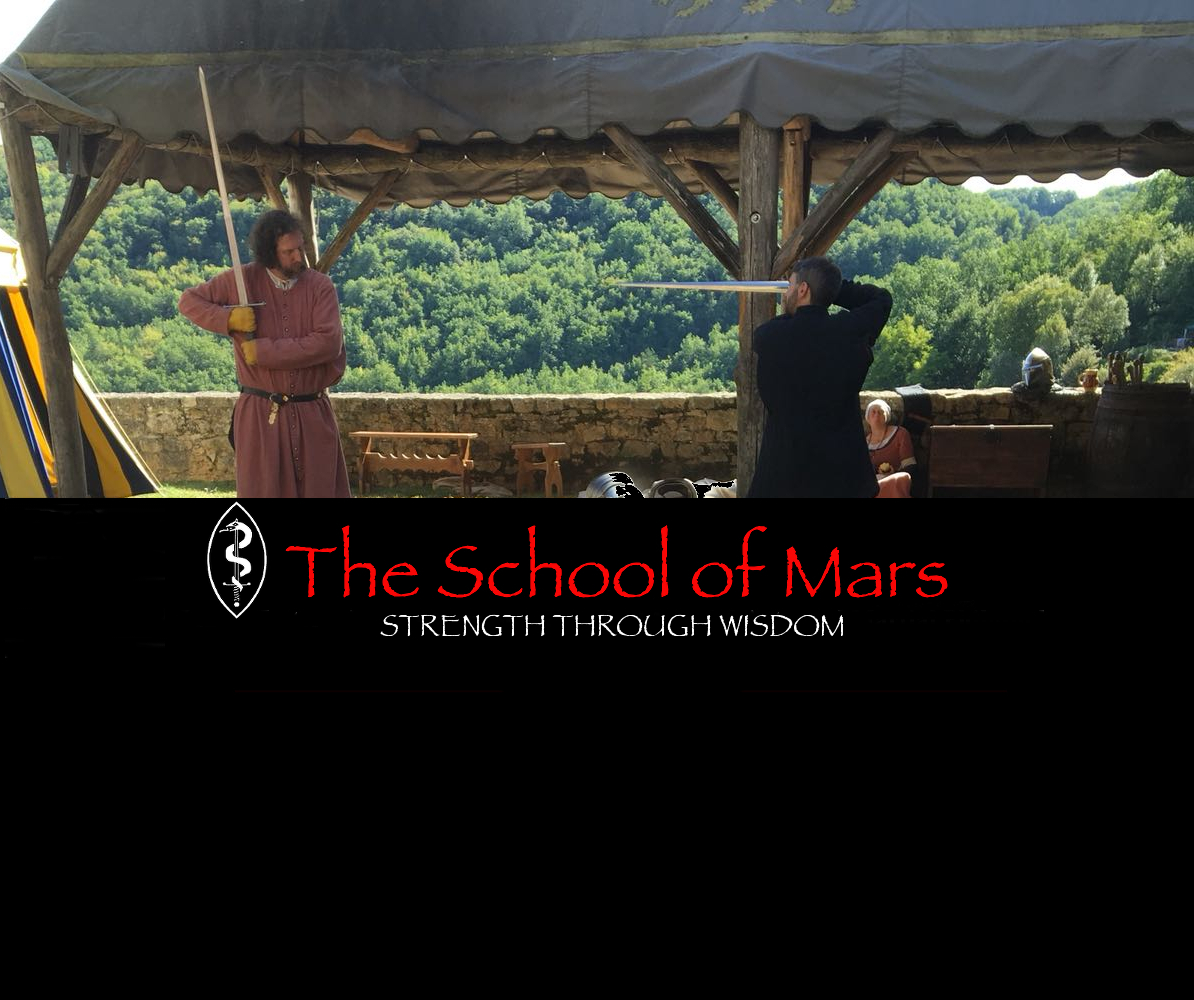
It’s not uncommon for me to respond to the question ‘So what do you do?’ by saying that I’m a swordsman. While this is partly for a bit of fun, to a greater extent it’s reasonably accurate. Starting at 15 performing fight shows at Renaissance Festivals, then studying the techniques preserved in treatises written by early fencing masters while caring for Britain’s national collection of arms and armour at the Tower of London and later receiving a PhD in medieval European martial arts, for me the sword has gone well beyond a mere passion or an academic pursuit.
Yet my pursuit of swordsmanship has also become more than just learning a lot about swords and how to use them well. Over the years, it has become an all-encompassing guide, a ‘Way’ as the Chinese or Japanese would say. For if we study it closely, the sword has a lot to teach us about life and how to live it.
Of course, I’m not the first to use a physical pursuit as a model for living. Around two thousand years ago the sage Patanjali is said to have compiled the Yoga Sutras which lays out eight ‘limbs’ or components of practice gradually leading the student to mastery and knowledge of the self. Students of Kendo (‘The Way of the Sword’) can take their practices beyond the physical pursuit into philosophical dimensions as exemplified by masters such as the legendary Miyamoto Musashi. The same is true for many Chinese martial arts, as when my Shifu remarks that he is not just teaching me Taiji, but rather Taiji Dao (‘The Way of Taiji’). While there are some cases in Western culture of secular activities being given allegorical and philosophical overtones, as for example when Freemasons ascribe added meaning to the tools and techniques of architecture, it’s far less common here.
Let’s look closer at some of the lessons that sword practice can teach us as students of self-realisation.
First, however, I should point out that, even though none of us are likely to ever use a sword in earnest, life-or-death combat, I still treat art of the sword as fundamentally a killing art — training to defend oneself in combat and, if necessary, dispatch an opponent to do so — rather than focusing on its modern sporting setting. The sword, as a dear friend and former teacher is fond of saying, is the direct ancestor of the nuclear bomb; it is arguably the first tool invented by humans with no other possible purpose than to harm another person. For those of us who undertake sword training, we would do well to have no illusions about this. When I was initially trained in swordplay, in my stage combat days, I was first taught how to fight in earnest, and then I was taught to moderate my techniques to ensure the safety of my scene partners. I maintain that it is much easier to cultivate the techniques and mindset of actual combat and then temper them accordingly, than it is to learn a sporterised combat form and attempt to later inject the intention of following through. So even though I have no illusions about actual sword combat being a necessity in our modern world, for training I proceed as though it is.
So if some of what is below comes off as a bit… grave? You’ll understand where I’m coming from.
Balancing simultaneous living in the worlds of peace and war
Martial training makes a person more adept at inflicting effective violence. To quote Parker’s Law: ‘With great power comes great responsibility.’ So you’ve got to have a code; something that helps you to live as a person who can be trusted with being dangerous in a society that defaults to peace.
But part of learning to use a sword is learning when it is necessary to draw it. When that time comes, the code which allows you to function harmoniously in society can become a liability. ‘Be as careful as you would be with death that your [sword]play is not courteous’ warns the 15th century Italian fencing master Philippo di Vadi. Living by a set of guiding principles which promote peaceful and equitable existence with your fellow beings is essential. But equally essential as a student of the sword is a solid understanding of the circumstances — ideally as rare as is possible — under which those principles must be temporarily set aside to overcome an opponent.
Teaching the body to get out of its own way
Mastering any physical practice amounts to teaching your body to get out of its own way. It’s inevitable that, when starting out, our stances, guards, and attacks feel as though we’re performing them in a deep sea diving suit. Once we have the coarse movements sorted, however, we then start fine tuning.
Gradually we start to notice that by shifting our stance a bit like so, and by relaxing your shoulders like so, techniques become easier and more powerful than before. On top of this, taking notice of breathing, learning to breathe efficiently, and working to improve breath capacity adds even more power to movements and enables you to fight for longer.
But this fine tuning extends beyond just becoming a better fighter. It teaches us to pay attention to our bodies, to more quickly notice when something is out of alignment or uncomfortable, and to become more generally aware of how we carry ourselves in day to day life.
The Sword of Truth really does cut away delusion… amongst other things
Even under safe sparring conditions where everyone involved knows that they’ll be walking away afterwards in one piece, having a metre-long blade arcing towards your head is remarkably effective in clearing the mind of unimportant things. We could be flawless in the execution of our techniques, but if we can’t think clearly and decide in the moment which ones to employ during a fight, those flawless techniques aren’t worth much.
If we think about Boyd’s OODA Loop (Observe, Orient, Decide, Act) model for decision making, then the mental training of swordplay enhances our abilities to effect the first three points and bring our actual techniques (the Act) to bear. By reducing distractions from unimportant internal and external ‘noise’ and by learning to focus and hold our attention where we choose, we can take in a situation more quickly and fully, and maintain the presence of mind to respond correctly even when under pressure.
Meeting yourself, and meeting Death
Once the body is stable and the mind is focused and free from distraction, we are finally in a position to actually become aware of ourselves and our surroundings. Most of us know about this sort of practice from sitting meditation — and I definitely encourage my students to take this up as a supplementary practice — but the same state can be cultivated once we have achieved the equivalent physical and mental stability in our sword practice. There comes a point when we are no longer constantly micro-adjusting our stance and weapon positioning, and when we are no longer filled with thoughts about either making these adjustments or day-to-day matters not related to our sword work, when we are simply doing the techniques.
But eventually, after continuing in this state for increasing periods of time, there is yet another shift. The doing, and the doer, drop away as well. Different traditions have different names for this state, and they’re all in agreement that it’s pretty difficult to describe in much detail. But they are also in general agreement that it is a state in which it becomes possible to gradually arrive at profound insights about oneself.
As fencers (not in the Olympic sense, but rather as students of the Art of Defence), we are also in a unique position to use this state to contemplate a particularly thorny issue: Death. Even if we are fighting for sport, and our safety is guaranteed to the greatest possible extent, we would do well to understand the attitude of our ancestors who, when squaring off against an opponent with a drawn weapon, were playing for keeps. Fear of death, and the tendency to flinch away from it, is a perfectly healthy reaction. But it is also a liability in swordplay, and indeed in many points in life, that needs to be overcome.
So from this state of detached absorption, whether sitting or with sword in hand, we stare at death, the idea of death. Eventually we achieve a deeper understanding of what precisely it is — and perhaps more importantly, what it is not — and thus it becomes that much less scary and taboo. Then, when we are in situations (simulated or otherwise) where death is a possible outcome, we are better able to push through our instinct to shrink and flinch, and instead can react with the appropriate response to hopefully put it off for another day.
While my training system incorporates this four-fold structure of cultivation (ethical, physical, mental, and philosophical), although this sequence is in some ways progressive, all four pillars are inextricably linked. Aspects of each support and enable the others. Ethical cultivation, by removing needless conflict and disturbances in one’s life, paves the way for building mental stability. The ability to focus the mind allows you to gradually wean it off of attention to the body and the mental noise and open up the possibility of philosophical cultivation. And insights such as the diminishing fear of death from philosophical cultivation bolsters a fencer’s fortitude and enables them to keep a cooler head in the heat of the moment.
We don’t have to be knights or samurai for sword training to bring us immense physical, mental, and (dare I say?) spiritual benefits. Even if we never pick up a sword outside of practice sessions, the lessons learned in practice serve us just as well in our daily lives: when to fight, and when to deal; greater control of your body and your mind; deeper awareness of our instinctual reactions and their origins, and using that knowledge to temper them accordingly.
This is how the Way of the Sword can be lived today.
